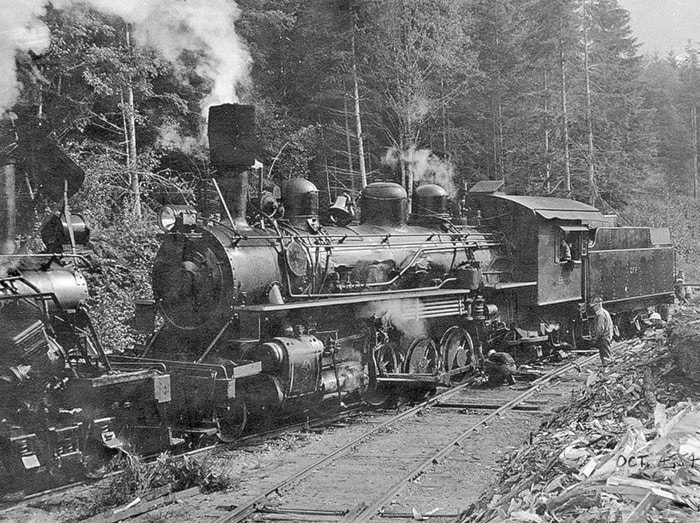Catherine Gilbert
Museum at Campbell River
Railway logging became an essential part of the logging industry on Vancouver Island from the 1900s right through to the 1950s. When loggers came to Vancouver Island and the adjacent islands in the late 1800s, they were able to harvest timber that grew right along the shorelines.
As these stands were depleted, they ventured inland, and horses and oxen were used to haul the logs out and down to shore to be shipped. Railway logging developed out of the need to access stands of timber that were even further back in the bush and before long, there were miles of networks of rail reaching into the interior of Vancouver Island and on some of the other outlying islands.
Robert D. Turner in Logging By Rail, the British Columbia Story wrote that “all along the coast and in a few interior locations, the hills echoed to the sound of the whistles of the locomotives.”
Initially it was smaller and midsized companies that undertook railway logging, and Howard White in Raincoast Chronicles First Five remarked that “Few people realize just how many logging railroads there were.
After 1930, it was pretty well just the big outfits that had them, but before that they were all over the coast, with the greatest number on Vancouver Island.”
During the boom years of the 1920s, manufacturers were striving to keep up with the number of orders for locomotives from logging companies, and they were continually trying to improve the equipment. Even so, these steam driven machines could break down, and maintenance on locomotives in the woods presented many problems to the crews, who took pride in their equipment and their ability to maintain it.
In Campbell River during those years, International Timber Company had one of the largest logging railroad operations on Vancouver Island. These assets were then taken over by Elk River Timber Company in 1930. One of Elk River Timber’s chief camps was Camp Eight, located 15 kilometres west of Campbell River at Echo Lake.
Bloedel, Stewart and Welch had an impressive rail operation at Menzies Bay, and their railways ran from the bay reaching inland to the forest lands. Camp Five, created in 1942 on the shore of Brewster Lake, was a railway logging camp. It housed about 500 people, including 40 families, and even had its own school.
Some self-sufficient camps evolved into communities – like Camp Five at Brewster Lake, and the Rock Bay and Nimpkish Camps. Salmon River Logging brought about 200 workers into Kelsey Bay in 1938 and operated a rail logging concern.
Although most workers were transient, some stayed in Kelsey Bay and became part of the community.
Woss Camp (between Sayward and Port McNeill) is the only remaining railroad logging camp and operation in British Columbia.
By the 1930s, only the larger companies kept trains running in the west coast forests. Just like horses and oxen, trains had their limitations. They could only be used where the terrain was relatively flat, and were unable to go up steep grades.
Trucks, which made their first appearance in the logging industry prior to WWI, were becoming the preferred method of transporting logs as they could access steep inclines and haul logs along steeper grades.
As truck logging became increasingly popular, this spelled the demise of camp life, as men could easily commute to and from home on the roads built for logging trucks.
In time, most of the rail lines were pulled up and the trestle bridges dismantled, but parts of lines and trestles can still been seen in the woods in places such as Camp Lake, Loveland Bay, Goose Neck Lake and along the road to Rock Bay.
Railways and trains still hold great fascination for many, as evidenced by the well-attended Train Show the Museum holds every year, put on by the North Island Model Railroaders. This year the event is taking place January 30 and 31.
To learn more about the Campbell River region’s more prominent logging camps, and their trusty steam engines, come see Logging Locomotives, a photographic exhibit in the Museum’s temporary gallery, until Feb. 21.
